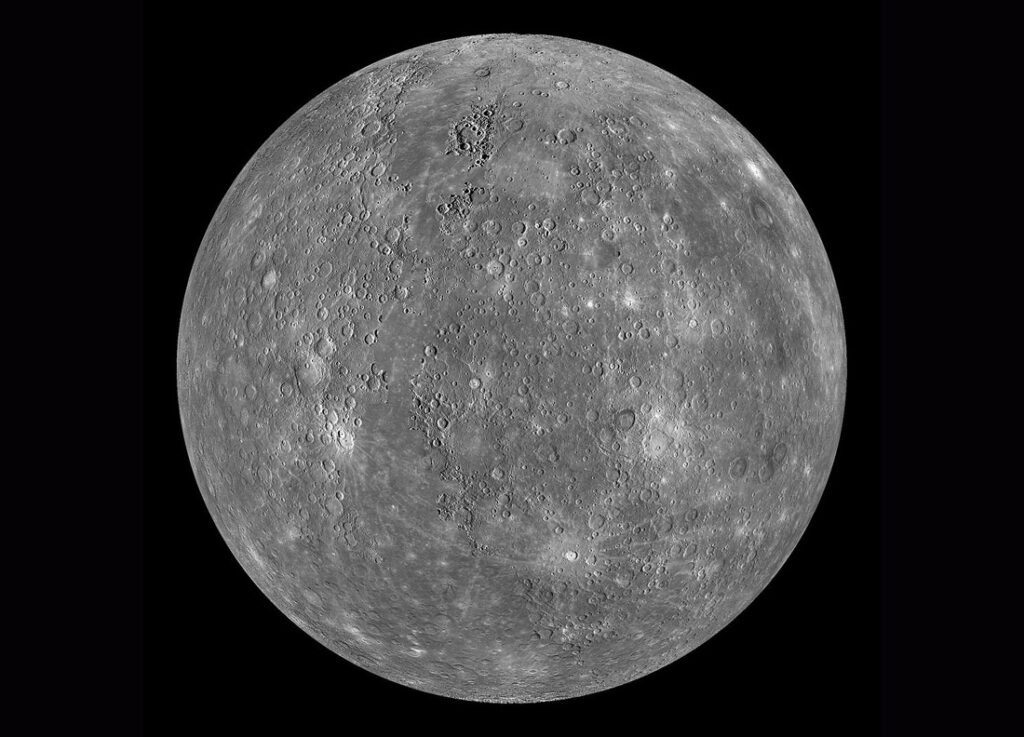The small, rocky planet Mercury is the innermost planet in our solar system and the closest planet to the Sun. Mercury´s orbit around the sun is not a circular path but an elliptical orbit. The distance changes between 47 million kilometers and 70 million km. Mercury orbits the sun in 88 Earth days, with a speed of 50 km/sec and is so faster than any other planet. Due to its proximity to the Sun arises a temperature of 467 ° C on the day side, which falls at night to -183 ° C, as Mercury has no Earth-like atmosphere.

Due to Mercury´s proximity to the Sun, he can only be seen from Earth in dusk or dawn. Prior to 1965, scientists thought that always the same side of Mercury is presented to the Sun. Then astronomers discovered that Mercury rotates 3 times his axis while he orbits the sun 2 times. One day on Mercury therefore lasts 176 Earth days.
Like our Moon Mercury has no atmosphere. Without a surface-protecting atmosphere there is no erosion and so no weather patterns like on Earth. And also there is no protection against meteorite impacts. So Mercury is littered with thousands of meteorite craters.
The Caloris Basin, the biggest feature on Mercury, has a diameter of 1300 km. It is the result of an asteroid impact during the formation of our Solar System. This is probably the reason for the peculiar surface on the opposite side of the planet. Over the next 500 million years Mercury cooled and its surface shrank to a radius of 2 up to 4 km. The outer crust, the Lithosphere, was compressed and was strong enough to prevent the magma inside to reach the surface before it is cooled and thus completed the geological activity of Mercury. Evidences of this time are the smooth plains in the Caloris basin.
Mercury is the smallest planet in our solar system. If the Earth were the size of a baseball , Mercury would be a golf ball. Seen from Mercury, the sun would be three times bigger than from Earth. Mercury is the second densest body in our solar system, just after the Earth. Its interior consists of an iron core with a radius of 1800 to 1900 km, which is about 75 % of its diameter and the same size as our Moon. The outer shell, which is comparable to the Earth’s , is only 500 to 600 km thick.
1974 and 1975 Mariner 10 as first spacecraft flew by at Mercury. Mariner 10 discovered that Mercury has a very weak magnetic field like the Earth, which was a big surprise at this time. In 1991 astronomers discovered using radar observations water ice at the North and South Pole of Mercury. The ice exists in deep craters that are always in the shade and where the sun cannot melt the ice. In 2004 MESSENGER started to Mercury and swerved after several flyby maneuvers on Earth, Venus and Mercury in an orbit in 2011. MESSENGER is next to Mariner 10 the second spacecraft visiting Mercury, and the first to surround him as Orbiter.
| Discovery date | unknown |
| Semi-major axis | 57 894 375 km = 5.789 x 107 km (0.387 AU) Comparison: 0.387 x Earth |
| Perihelion | 45 926 546 km = 4.592 x 107 km (0.307 AU) Comparison: 0.307 x Earth |
| Aphelion | 69 862 205 km = 6.986 x 107 km (0.467 AU) Comparison: 0.467 x Earth |
| Diameter | 4879.4 km = 4.8794 x 103 km Comparison: 0.3825 x Earth |
| Circumference | 15 329.1 km = 1.53291 x 104 km |
| Volume | 60 827 200 000 km3 = 6.08272 x 1010 km3 Comparison: 0.054 x Earth |
| Mass | 330 220 000 000 000 000 000 000 kg = 3.3022 x 1023 kg Comparison: 0.055 x Earth |
| Density | 5.427 g/cm3 Comparison: 0.984 x Earth |
| Surface area | 74 800 000 km2 = 7.48 x 107 km2 Comparison: 0.108 x Earth |
| Surface gravity | 3.7 m/s2 Comparison: Someone with 100 kg on Earth, would weigh 40 kg on Mercury. |
| Escape velocity | 15 300 km/h = 4.25 x 103 m/s Comparison: 0.3844 x Earth |
| Sidereal rotation period | 58.646 Earth days 1407.5 hours |
| Orbital period (Length of a year) |
0.241 Earth years 87.97 Earth days |
| Average orbital speed | 172 341 km/h = 47 872.5 m/s Comparison: 1.61 x Earth |
| Eccentricity | 0.20563069 Comparison: 12.3 x Earth |
| Inclination | 7° |
| Axial tilt | 0° Comparison: The Equator deviation from the orbit of the Earth is 23.45°. |
| Peripheral orbit | 356 000 000 km = 3.56 x 108 km Comparison: 0.385 x Earth |
| Minimum/Maximum surface temperature |
-173/427 °C = 100/700 K Comparison: The temperature of the Earth is ~ 185/331 K. |
| Composition of the atmosphere |
Comparison: The atmosphere of the Earth is mainly composed of N2 and O2. |
Moons:
Mercury has no moon.